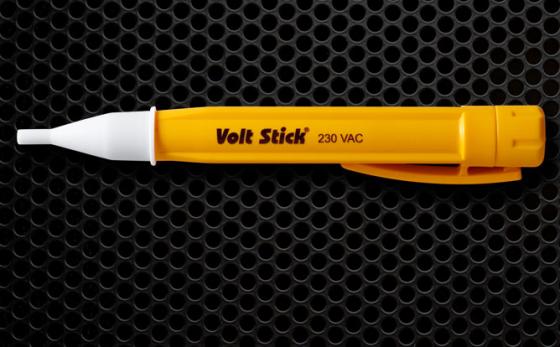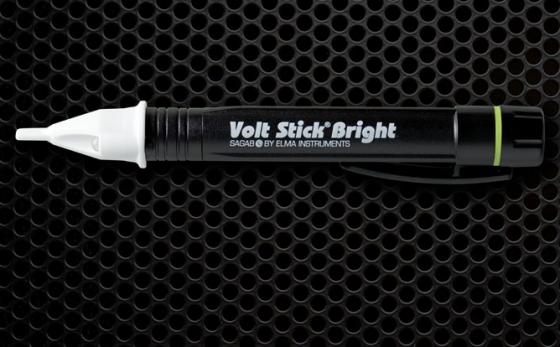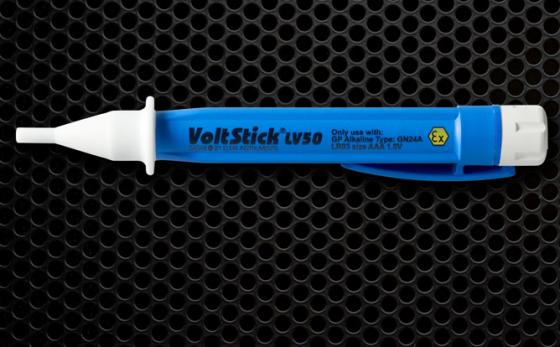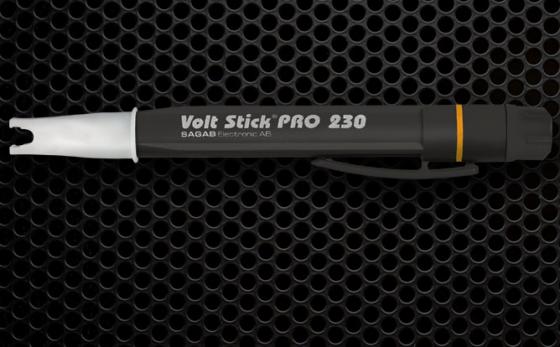How to use a Volt Stick non-contact voltage tester
Though a non-contact voltage tester is simple and quick to operate, understanding the many technical and environmental factors that can affect the test results is essential.
Volt Stick (sometimes also referred to as a volt pen, voltage indicator or wand) is a non-contact tester pen which provides simple, accurate testing for the presence of voltage, without the complications of more detailed multimeters, clamp meters etc.
So for engineers, electricians, builders, plumber, etc who are working on an unknown site or system, it is important to safety-check an area, device or piece of equipment for live voltage before beginning any work.
You would be forgiven for thinking that using a Volt Stick is always a simple task and - in most circumstances - it is. But there are many factors which you need to consider and be aware of that will help you get the most accurate test result from your voltage tester.
In effect, a Volt Stick should be used to confirm a result that you were already expecting (ie. the presence of a voltage) and that can only be achieved if you fully understand how a voltage detector operates and, very importantly, how other external factors can affect the test results.
(See also – How does a Volt Stick Work? )
Is a Volt Stick the correct tool for what you are testing?
-
Are you working on an AC or DC system?
Remember Volt Sticks will only find AC Voltages and not DC Voltages, so they will not work for the electrics in cars, caravans or DC transformers!
-
Is the object or device you’re testing armoured or shielded?
If it is, then a voltage tester will not work, as the electric field that a Volt Stick detects cannot escape the armour or shielding to activate the Volt Stick.
Is there anything surrounding the object you’re testing that could affect your results?
-
Is the object buried or under water?
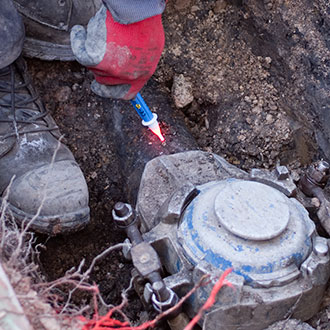 Again, earth and water will shield the electric field, so make sure you find an exposed clean part to test, do not touch the water or test through the water and assume it is safe! A volt pen tester will not be providing a test result.
Again, earth and water will shield the electric field, so make sure you find an exposed clean part to test, do not touch the water or test through the water and assume it is safe! A volt pen tester will not be providing a test result.
-
Is the object being tested freely hanging or against a wall or floor?
The size of the electric field can be effected by its positioning. There will be a larger electric field emitted from a freely-hanging cable than there would be for a cable against a wall or floor. So a voltage tester pen will detect from further away if the cable is hanging freely.
-
Are you testing something that is enclosed in a Metallic Casing or Trunking?
The Volt Stick will detect the presence of a voltage on the casing but not through the casing, you will need to open it to test what’s inside.
-
Are you trying to test cables through plastic trunking?
Again it will depend on how far the live conductor is from the voltstick sensor and whether it is sensitive enough to detect the electric field, therefore it is best to open the trunking to get closer
Is there anything surrounding you that could affect your results and give you a false live indication?
-
Are you close to high voltage overhead cables?
The large electric field from high voltage overhead lines can be detected by a Volt Stick and make the object you’re testing appear live when it isn’t.
-
Are you stood next to an electric cable or perhaps standing above hidden under-floor cabling?
Again, if the object you’re testing has a path to earth, then the field from a nearby electric cable can be detected by your Volt Stick and make it appear that the object you’re testing is live when it may not be. If this happens, move away from the suspected interference and test your object again and see if the results change.
-
Are you working near to fluorescent lighting?
Fluorescent lights can emit a large electric field which can be detected by your voltage tester, which may make it appear like the object you’re testing is live; if it’s safe to do so, turn the lights off and test again.
Is there anything surrounding you that could affect your results and give you a False Negative?
-
Are you testing a device or cable that could be affected by a timer switch, or a remote sensor?
...for example a boiler or a security light. It’s important to be aware of what is controlling the power to what you are testing. It’s possible to test something and the non-contact voltage tester tell you the area/device is safe and then a remote switch turns on the power and the device becomes live without your knowledge!
-
Are you working off the ground?
Volt Sticks work on the principal of Capacitive Coupling and you are part of that Capacitive Circuit. So if you are too far from a ground/earth then the capacitive circuit is broken and the voltstick won’t work.
Are you using the right Volt Stick model?
-
What size voltage are you expecting to find? 12v, 230v, 1000v?
The larger the voltage present, then the bigger the Electric Field will be around the object you are testing, and so the Volt Stick will detect from further away. Vice versa a small voltage will only give a small Electric Field and so you will need to get closer to detect it.
For larger voltages you will need a less sensitive Volt Stick and for smaller voltages you will need a more sensitive Volt Stick. So it’s important to know the sensitivity of your Volt Stick and use the right one for the job.
-
Are you testing Multi Core Cables?
In a multi-core cable, the live conductor could be either side of the cable and the voltage tester you are using might not be sensitive enough to detect it if it’s on the other side! So it’s important to always test the entire circumference of a cable.
-
Are you testing Single Core Cables?
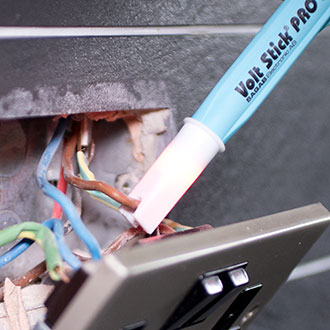 If your Single Core cable is on its own with no other cables near by, then this should be relatively easy to test. Simply move the tip or antenna of the voltage detector near to the cable and it will illuminate if there is an AC Voltage present.
If your Single Core cable is on its own with no other cables near by, then this should be relatively easy to test. Simply move the tip or antenna of the voltage detector near to the cable and it will illuminate if there is an AC Voltage present.
However if you have a bundle of Single Core Cables and it’s not possible to separate them then it could be difficult to tell which cable is giving a live indication.
This is another example of having the right tool for the right job! Our Volt Stick Pro models have a specially designed tip/antenna so you can select and test individual Single Core Cables whilst shielding from the Electric Fields of adjacent cables.
-
Are you testing Electrical Sockets or Outlets?
As with multi-core cables it’s important to think about where the live conductor is behind the socket and if the sensor of your voltage tester is able to reach it. It is best to use a Volt Stick with a tip/antenna that will fit inside the socket so that it will be as close to the conductors as possible.
-
Are you testing a metallic cabinet or enclosure to make sure it’s safe to open?
Voltages above 50v can be fatal so make sure you are using a Volt Stick that can detect from 50v upwards.
Another thing to consider is how you hold the tip/antenna to the the object you’re testing.
Depending on the design of the voltage meter, some Tips/Antennas will be more sensitive when held side-on because they are exposing more of the Antenna to the electric field.
Having considered everything above you should be confident to use your Volt Stick Tester and understand the results it gives you; hopefully we’ve covered most things that could affect the results.
Voltage Test Procedure
- Before you start, check your Volt Stick on a known live, preferably in the area you are going to test. If your Volt Stick has an Audible Indicator and it fails to sound then the batteries may need replacing.
- Move the Volt Stick close to the object you need to test and be careful not to touch any exposed metal work with your hand or any other part of your body.
- If there is an AC Voltage present, then the tip of the Volt Stick will illuminate and, if the Volt Stick has an Audible Indicator, it will sound.
- Having finished testing, check your Volt Stick again on a known live to make sure it is still working correctly.
- Remember if your Volt Stick doesn’t give you the result you were expecting, check the conditions above. If it indicates a live Voltage, the Volt Stick will be detecting a nearby Electric Field even though it might not be obvious.
- The amount of times we hear customers complaining that their Volt Stick doesn’t work only to find that they are using it incorrectly, the most common error is not testing the whole circumference of a multi Core cable!
Which Volt Stick do I need?
As the original developer of the non-contact voltage tester, Volt Stick offers the widest range of voltage tester models on the market. CLICK HERE FOR THE FULL RANGE.
Available in a choice of voltage ranges, with or without ATEX approval and with a choice of tip/antenna shapes for differing applications, Volt Stick has the right product to ensure safe working on site.
Need more advice?
Contact the Volt Stick team today.



